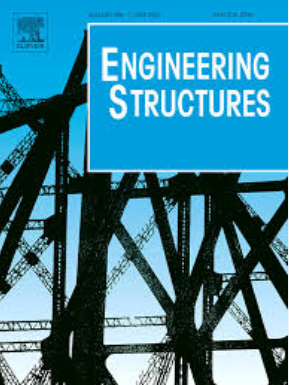火灾中约束钢柱的一致热力学分析。第1部分:一般应用的理论发展
IF 5.6
1区 工程技术
Q1 ENGINEERING, CIVIL
引用次数: 0
摘要
本文提出了一种描述约束钢柱在火灾中的性能的新方法。它以工程热力学的基本概念为基础。在结构工程师的相关时期,即在点火瞬间和柱倒塌瞬间之间,基于能量和熵的量相结合,为过程中涉及的热学和热力学问题提供了额外的联系。热力学分析是在宏观水平上进行的,通过适当的数学工具,如高斯散度定理,可以进入粒子水平。与传统的克劳修斯-杜昂公式相反,该描述清楚地区分了外部功和内部应变能。考虑到柱与周围框架之间的相互作用,柱采用了适当的结构模型。钢柱在火灾中的结构行为是两个力学现象的序列:热屈曲和塑性破坏。它涉及到热源之间的能量传递,热源是指由于任何我们不关心的原因而发生在柱体隔室的火灾,而热水槽,在这种情况下是柱体本身和周围的框架。该方法提出了一种新的方法来处理结构工程中通常采用的复杂数值方法产生的大数据。这意味着假设结构分析已经执行,我们将重点放在处理结构分析产生的信息上,以便更好地描述所涉及的现象,并为基于框架在火灾期间的能量吸收能力的新设计策略铺平道路。这项工作完全致力于一般性应用的理论发展。在基于体素的瑞利-里兹方法的背景下,一篇补充论文将这里开发的概念和策略应用于实际的说明性示例,并确认了本工作中提出的所有陈述。本文章由计算机程序翻译,如有差异,请以英文原文为准。
Consistent thermodynamics analysis of restrained steel columns in fire – Part 1: Theoretical developments for general application
The present paper proposes a novel way to describe the behaviour of restrained steel columns in fire. It is based on the fundamental concepts of Engineering Thermodynamics. Energy and entropy-based quantities are combined to provide an additional link between the thermal and the thermomechanical problems involved in the process, during the relevant period for structural engineers, that is between the ignition instant and the instant when the column collapses. The Thermodynamics analysis is made here at a macroscopic level and the passage to the particle’s level is made by means of the adequate mathematical tools, such as the Gauss’s Theorem of Divergence. In opposition to the traditional Clausius-Duhem formula, the description clearly distinguishes between external work and internal strain energy. An adequate structural model is adopted for the column, to take into account the interactions between the column and the surrounding frame. The structural behaviour of steel columns in fire is a sequence of two mechanical phenomena: thermal buckling followed by plastic collapse. It involves an energy transfer between a heat source, that is the fire that occurs at the column’s compartment due to any reason beyond our concern, and the thermal sinks, in this case the column itself and the surrounding frame. The proposed methodology proposes a novel way to treat the large data that arises from any sophisticated numerical methodology usually adopted in structural engineering. This means that it is supposed that the structural analysis is already performed, and we focus on the treatment of the information that arises from the structural analyses, to provide a better description of the involved phenomena and to pave the way to novel design strategies, based on the energy absorption capacity of frames during fire. This work is devoted solely to the theoretical developments for general application. A complementary paper applies the concepts and strategies developed here to real illustrative examples, in the context of the voxels-based Rayleigh-Ritz method, and confirms all statements presented in the present work.
求助全文
通过发布文献求助,成功后即可免费获取论文全文。
去求助
来源期刊

Engineering Structures
工程技术-工程:土木
CiteScore
10.20
自引率
14.50%
发文量
1385
审稿时长
67 days
期刊介绍:
Engineering Structures provides a forum for a broad blend of scientific and technical papers to reflect the evolving needs of the structural engineering and structural mechanics communities. Particularly welcome are contributions dealing with applications of structural engineering and mechanics principles in all areas of technology. The journal aspires to a broad and integrated coverage of the effects of dynamic loadings and of the modelling techniques whereby the structural response to these loadings may be computed.
The scope of Engineering Structures encompasses, but is not restricted to, the following areas: infrastructure engineering; earthquake engineering; structure-fluid-soil interaction; wind engineering; fire engineering; blast engineering; structural reliability/stability; life assessment/integrity; structural health monitoring; multi-hazard engineering; structural dynamics; optimization; expert systems; experimental modelling; performance-based design; multiscale analysis; value engineering.
Topics of interest include: tall buildings; innovative structures; environmentally responsive structures; bridges; stadiums; commercial and public buildings; transmission towers; television and telecommunication masts; foldable structures; cooling towers; plates and shells; suspension structures; protective structures; smart structures; nuclear reactors; dams; pressure vessels; pipelines; tunnels.
Engineering Structures also publishes review articles, short communications and discussions, book reviews, and a diary on international events related to any aspect of structural engineering.
 求助内容:
求助内容: 应助结果提醒方式:
应助结果提醒方式:


